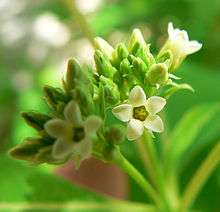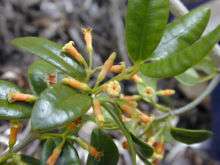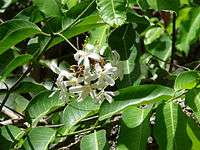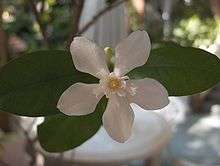Apocynaceae
| Apocynaceae | |
|---|---|
 | |
| Apocynum cannabinum | |
| Scientific classification | |
| Kingdom: | Plantae |
| (unranked): | Angiosperms |
| (unranked): | Eudicots |
| (unranked): | Asterids |
| Order: | Gentianales |
| Family: | Apocynaceae Juss. |
| Type genus | |
| Apocynum L. | |
| Synonyms | |
| Wikimedia Commons has media related to Apocynaceae. |
| Wikispecies has information related to: Apocynaceae |
Apocynaceae is a family of flowering plants that includes trees, shrubs, herbs, stem succulents, and vines, commonly called the dogbane family,[1] after the American plant known as dogbane, Apocynum cannabinum.[2] Members of the family are native to European, Asian, African, Australian, and American tropics or subtropics, with some temperate members.[1] The family Asclepiadaceae (now known as Asclepiadoideae) is considered a subfamily of Apocynaceae and contains 348 genera.
Many species are tall trees found in tropical rainforests, but some grow in tropical dry (xeric) environments. Also perennial herbs from temperate zones occur. Many of these plants have milky latex, and many species are poisonous if ingested. Some genera of Apocynaceae, such as Adenium, have milky latex apart from their sap, and others, such as Pachypodium, have clear sap and no latex.
Description
Growth pattern
The dogbane family includes annual plants, perrenial herbs, stem succulents, woody shrubs, trees, or vines.[1][3] Most exude a milky sap with latex, if injured.
Leaves and stems
Leaves are not divided into smaller leaflets (simple). Leaves may appear one at a time (singly) with each occurrence on alternating sides of the stem (alternate),[3] but usually occur in pairs or in whorls. When paired, they occur on opposite sides of the stem (opposite), with each pair occurring at an angle rotated 90° to the pair below it (decussate).
There is no stipule (a small leaf-like structure at the base of the leaf stem), or stipules are small and sometimes fingerlike.[3]
Inflorescence and fruit
Flowers are usually showy, have radial symmetry (actinomorphic), and are born in head that are cymes or racemes, but can rarely be fasciculate or solitary. They are perfect (bisexual), with a synsepalous, five-lobed calyx united into a tube at the base. Inflorescences are terminal or axillary. Five petals are united into a tube with four or five epipetalous stamens. The style is expanded at the apex into a massive clavuncle just below the stigma. The ovary is usually superior, bicarpellary, and apocarpous, with a common fused style and stigma.
The fruit is a drupe, a berry, a capsule, or a follicle.
Gallery
Taxonomy
As of 2012, the family was described as comprising some 5,100 species, where Apocynoideae, Asclepiadoideae, Periplocoideae, Rauvolfioideae, and Secamonoideae are its five subfamilies.[4] The former family Asclepiadaceae is included in Apocynaceae according to the Angiosperm Phylogeny Group III (APG III) modern, largely molecular-based system of flowering plant taxonomy.[5] An updated classification, including 366 genera, 25 tribes and 49 subtribes, was published in 2014.[6]
Distribution and habitat
Species in this family are distributed mainly in tropical regions:
- In the rainforests and swamps of Indomalaya: small to very tall evergreen trees up to 80 m tall, often with buttress roots, such as Alstonia and Dyera
- In northern Australia: small evergreen trees such as Alstonia, Alyxia, Cerbera and Ochrosia
- In deciduous forests of Africa and India: smaller trees such as Carissa, Wrightia and Holarrhena
- In tropical America, India, Myanmar and Malaya: evergreen trees and shrubs, such as Rauvolfia, Tabernaemontana and Acokanthera
- In Central America: Plumeria, or the frangipani, with its waxy white or pink flowers and a sweet scent
- In South America, Africa and Madagascar: many lianas, such as Landolphia
- In the Mediterranean region: Nerium, with the well-known oleander or be-still tree (Nerium oleander)
- The only genera found in temperate Europe away from the Mediterranean are Vinca (Apocynoideae) and Vincetoxicum (Asclepiadoideae). Also Asclepias syriaca is an invasive weed (e. g., in many areas of Ukraine).
- In North America: Apocynum, dogbane or Indian hemp, including Apocynum cannabinum, a traditional source of fiber
- In continental southern Africa (Angola, Botswana, Mozambique, South Africa, Swaziland, and Zimbabwe) and Madagascar, except for the humid evergreen forest of the eastern side of Madagascar, and never above 2000 m for the entire island: Pachypodium and Fockea
Ecology
Several genera are preferred larval host plants for the Queen Butterfly (Danaus gilippus).[7]
Toxicity
All plant-derived (i.e., phytochemical) natural products have some inherent toxicity on ingestion, and many are very toxic, even lethal. This is true of many contained in species of plants from the Apocynaceae family, which include several that are extremely poisonous if parts are ingested, or if they are not handled properly. Members containing cardiac glycosides—genera Acokanthera, Apocynum, Cerbera, Nerium, Thevetia, Strophanthus, etc.—have therapeutic ranges, but often are associated with accidental poisonings, in many cases lethal (see below). Alkaloid-producing species like Rauvolfia, Catharanthus, and Tabernathe are likewise the source of compounds with possible therapeutic ranges, but which have significant associated toxicities if not taken in appropriate doses and in controlled fashion.
Uses

Several plants of the Apocynaceae family members have had economic uses in the past. Several are sources of important natural products—pharmacologic tool compounds and drug research candidates, and in some cases actual prescription drugs. Cardiac glycosides, which affect heart function, are a ready example. Members studied and known to have such glycosides include the Acokanthera, Apocynum, Cerbera, Nerium, Thevetia and Strophanthus. Rauvolfia serpentina (Indian snakeroot) synthesizes the alkaloids reserpine and rescinnamine, which are of interest in studies of the treatment of high blood pressure, as well as some forms of psychosis. Catharanthus roseus yields alkaloids studied with regard to the treatment of cancer. Certain species of the genus Tabernanthe, most notably Tabernanthe Iboga contain tryptamine alkaloids such as ibogaine in the roots.
Several genera are grown as ornamental plants, including Amsonia (bluestar), Nerium (oleander), Vinca (periwinkle), Carissa (Natal plum), Allamanda (golden trumpet), Plumeria (frangipani), Thevetia (lucky nut), Mandevilla (Savannah flower), and Adenium (desert-rose).
In addition, the genera Landolphia, Hancornia, Funtumia and Mascarenhasia were used as a commercial source of inferior rubber (see Congo rubber, made mostly from various Landolphia species harvested in the wild).
There may be reports of limited dietary uses of plants from this family,—see however the section on toxicity above. The edible flower of Fernaldia pandurata (common name: loroco) is a popular part of El Salvadorian and Guatemalan cooking. Carissa (Natal plum) produces an edible fruit. The genus Apocynum was reportedly used as a source of fiber by Native Americans. The aromatic fruit juice from Saba comorensis (syn. Landolphia comorensis, the Bungo or Mbungo fruit) is a popular drink, on Pemba Island and other parts of coastal Tanzania.[8]
Finally, ethnopharmacologic and ethnotoxicologic uses are also known. Ibogaine-type alkaloids from the roots of genus Tabernathe have been used in traditional African tribal ceremonies as a source of hallucinogens, and have been studied with regard to the treatment of drug addiction. The juice of Acokanthera species such as A. venenata and the milky juice of the Namibian Pachypodium have reportedly been used as venom for arrow tips by the San people, though others have reported that Pachypodium do not produce such milk.[9]
References
- 1 2 3 Endress ME, Bruyns PV (2000). "A revised classification of the Apocynaceae s.l.". The Botanical Review. 66 (1): 1–56. doi:10.1007/BF02857781.
- ↑ Heiser CB (2003). Weeds in my garden: observations on some misunderstood plants. Portland, Oregon: Timber Press. p. 50. ISBN 0-88192-562-4.
- 1 2 3 Apocynaceae, Thomas Rosatti, Jepson Herbarium
- ↑ Nazia Nazar, David J. Goyder, James J. Clarkson, Tariq Mahmood and Mark W. Chase, 2013, "The taxonomy and systematics of Apocynaceae: Where we stand in 2012," Bot. J. Linnean Soc., 171(3, March), pp. 482–490, see , accessed 22 June 2015.
- ↑ Angiosperm Phylogeny Group (2009). "An update of the Angiosperm Phylogeny Group classification for the orders and families of flowering plants: APG III". Bot. J. Linnean Soc. 161 (2): 105–121. doi:10.1111/j.1095-8339.2009.00996.x.
- ↑ Endress M.E., Liede-Schumann S. & Meve U. (2014). "An updated classification for Apocynaceae" (PDF). Phytotaxa. 159: 175–194. doi:10.11646/phytotaxa.159.3.2.
- ↑ Klots, Alexander B. (1951). A Field Guide to the Butterflies of North America, East of the Great Plains. Cambridge, Massachusetts: The Riverside Press. pp. 77–79.
- ↑ "Saba comorensis in Agroforestree Database" (PDF). Retrieved 30 July 2012.
- ↑ Rapanarivo SHJV, Leeuwenberg AJM (1999). "Taxonomic revision of Pachypodium. Series of revisions of Apocynaceac XLVIII". In Rapanarivo SHJV. Pachypodium (Apocynaceae): taxonomy, habitats and cultivation. Balkema. pp. 1–82. ISBN 978-90-5410-485-8.

_W_IMG_3208.jpg)
_W2_IMG_3219.jpg)



